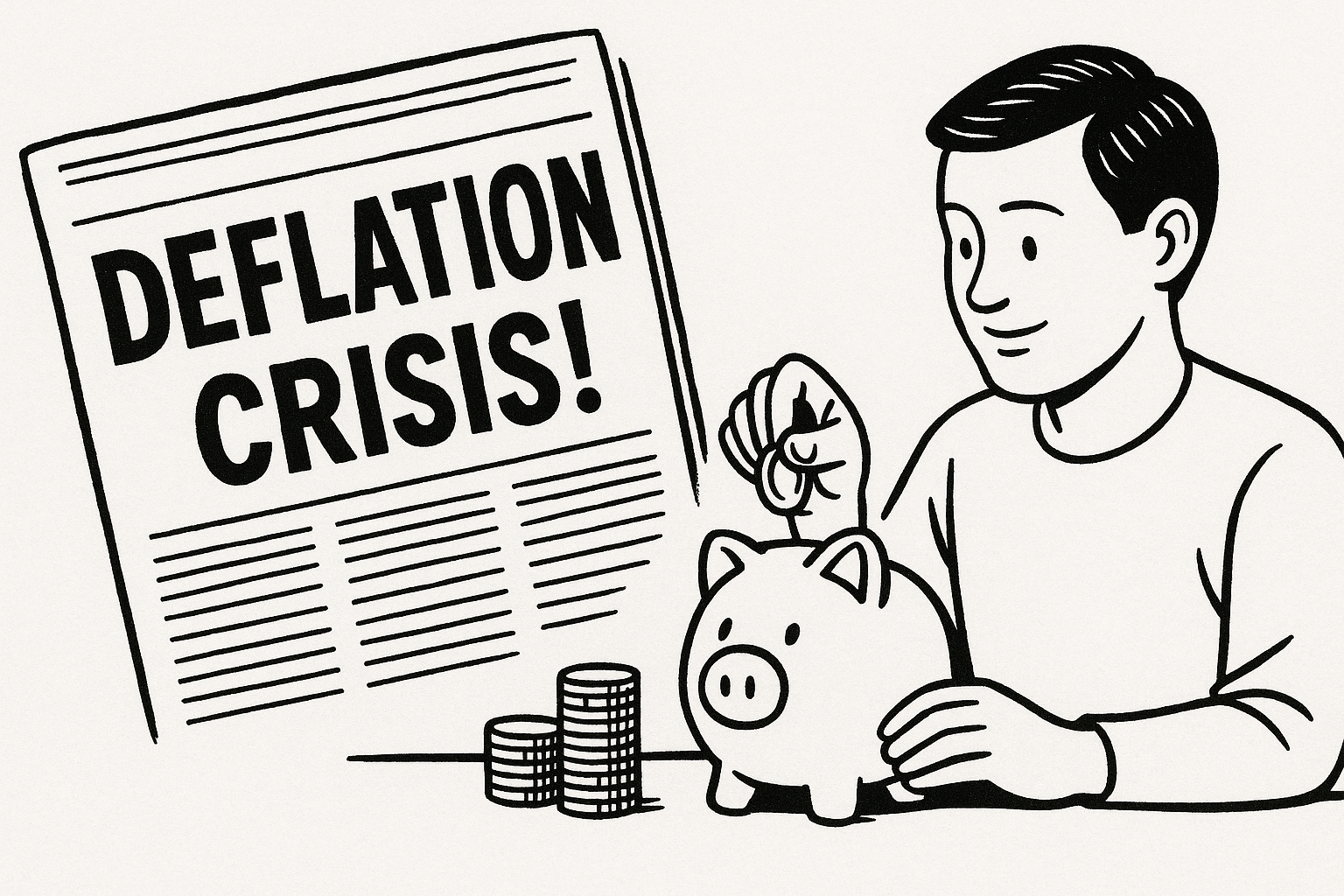💥 “Deflation is dangerous.”
It’s one of the most repeated warnings in modern economics.
You’ve heard it in classrooms, news headlines, and central bank speeches. But why, exactly?
What if we flipped the script?
What if deflation isn’t the monster under the bed — but the flashlight that reveals the fragility of a system built on debt?
Let’s break it down.

Above: Fear-driven narratives obscure the real dynamics behind deflation.
🔥 What Is Inflation, Really?
Before we understand deflation, we need to talk about inflation.
Mainstream Definition:
Most textbooks and central banks define inflation as a general rise in prices across the economy. You’ve probably heard something like: "Inflation is when your groceries, rent, and energy bills all get more expensive."
To manage this, institutions like the Federal Reserve aim for a 2% annual inflation rate, believing that steady price increases encourage spending and borrowing while discouraging hoarding.
But there's a deeper issue here.
The Austrian Perspective:
From the Austrian School of Economics, inflation is not defined by prices — but by money supply.
Inflation = an artificial increase in the supply of money and credit.
Price increases are merely a consequence — not the root cause. In fact, prices might stay stable or even drop despite inflation, thanks to technological innovation, globalization, or supply chain efficiencies.
This view matters because it changes what we measure — and what we fear.
- In the mainstream view, no inflation = no problem.
- In the Austrian view, money printing itself is the problem, even if prices haven’t risen yet.
And this misunderstanding has profound consequences.
When inflation is misdiagnosed as a price phenomenon rather than a monetary one, it justifies constant credit expansion, debt accumulation, and interest rate manipulation.
Which brings us to the supposed villain: deflation.
🧊 What Is Deflation, Really?
Deflation is simply a sustained decrease in the general price level of goods and services. Put plainly: your money becomes more valuable over time.
There are two main scenarios that can lead to deflation:
1. Productivity Growth & Sound Money
In a healthy, growing economy with a sound monetary base (like gold or Bitcoin), deflation can happen naturally due to increased productivity and innovation. As businesses become more efficient, goods and services become cheaper. Your money buys more — not because demand has crashed, but because value creation has increased. This is a sign of progress, not collapse.
2. Credit Collapse & Demand Shock
On the other hand, deflation can also occur during a severe crisis of confidence — typically involving fractional-reserve banking failures. When consumers stop spending, banks stop lending, and defaults rise, money supply contracts sharply. Prices fall — not from abundance, but from panic and broken trust. This kind of deflation often accompanies depressions, like the 1930s.
Understanding the cause of deflation is key to understanding whether it’s a healthy adjustment or a systemic failure.
In a deflationary world:
- Your purchasing power increases
- Saving money makes sense
- Salaries can stretch further
Yet economists scream: “No! This leads to economic disaster!”
Why?
🏗️ Because the System Wasn’t Built for That
Here’s the uncomfortable truth:
Our economy runs on debt — not productivity, not savings. Debt.
Governments borrow endlessly. Corporations roll over liabilities year after year. Consumers are encouraged to finance everything — from cars to coffee machines.
This works (temporarily) because inflation erodes the real value of debt.
Borrow $1,000 today → repay it in 10 years with dollars worth less.
That’s how fiat inflation rewards borrowers and punishes savers.
But under deflation? That trick doesn’t work.
⚖️ Why Deflation Makes Debt Heavier
Imagine you borrowed $100,000 at 0% interest.
In an inflationary world (say 5% per year), you’re effectively repaying that loan with weaker money each year. By year 10, your $100,000 feels like $60,000.
In a deflationary world (say -2% per year), the opposite happens. Now, your debt becomes more burdensome over time — even if interest rates stay flat.
That’s why debt-fueled systems can’t handle deflation:
- Government interest payments explode
- Zombie companies collapse
- Banks’ balance sheets shrink as borrowers default
In short: deflation exposes who’s been swimming naked.
🧠 The Austrian View: Deflation = Market Healing
While Keynesian economists treat deflation like a disease, Austrian economists see it differently.
According to the Austrian school:
- Deflation is not inherently bad
- It’s often the market correcting itself after a credit-fueled boom
- It discourages reckless borrowing and rewards capital accumulation
In their eyes, the real illness is malinvestment — the bad decisions made when interest rates are artificially low, credit is easy, and money is cheap.
Deflation is the market’s detox.
🔄 What the System Fears Isn’t Deflation — It’s Honesty
Let’s be blunt:
Deflation isn’t feared because it hurts people. It’s feared because it hurts the institutions addicted to inflation.
A deflationary environment forces:
- Governments to live within their means
- Companies to invest cautiously
- Consumers to value long-term thinking
It punishes excess and rewards prudence.
That’s why central banks panic at the first sign of falling prices. That’s why media spins the “deflation = depression” narrative.
Because a deflationary system doesn’t let you hide behind leverage.
📈 Would Deflation Really Be So Bad?
It depends who you ask.
👎 For overleveraged governments and financial institutions? A nightmare. 👍 For disciplined savers, builders, and future-focused individuals? A blessing.
A world with stable or mildly deflationary money:
- Encourages saving
- Reduces speculative bubbles
- Demands productivity over manipulation
- Builds real wealth, not paper wealth
In many ways, it’s the antithesis of our current model.
🏭 Sound Money vs. Fiat: Real Resource Allocation

Above: Entire cities built in China with no residents — a byproduct of credit-fueled malinvestment.
Sound money doesn’t just reward savers — it allocates capital more honestly.
When interest rates reflect real savings (not central bank manipulation), entrepreneurs can make rational decisions. They invest in what people actually want, not what’s subsidized by cheap money.
But in a fiat system?
- Ghost cities get built in China — not because people need homes, but because credit is abundant
- Startups raise billions without profits because of zero-rate speculation
- Consumer goods companies survive only because inflation pressures people to spend now, not later
Malinvestment isn’t a bug. It’s a feature of fiat.
In a sound money environment, capital has to earn its way. There are no bailouts for bad ideas. There’s no infinite credit to paper over inefficiencies.
This leads to:
- Fewer bubbles
- Less waste
- More meaningful innovation
- Products and services that actually solve problems, not chase subsidies
Austrian economics argues that when money holds value, human time and effort are respected. Fiat systems distort this — rewarding short-termism and consumption over long-term value creation.
 Above: Waste and overproduction — consequences of a fiat economy that encourages overconsumption, not sustainable value.
Above: Waste and overproduction — consequences of a fiat economy that encourages overconsumption, not sustainable value.
🧹 Deflation Exposes Fake Value — Inflation Hides It
One of the most powerful effects of deflation is that it forces businesses to stand on their own merits.
Under inflation, weak or unprofitable companies can appear healthy:
- They benefit from rising nominal revenues
- They rely on cheap debt to survive
- They count on constant consumer spending driven by fear of rising prices
In a deflationary world, these crutches disappear. Demand becomes more selective. Capital costs rise in real terms. Only productive, efficient businesses survive.
This makes deflation a truth serum:
- Zombie companies lose access to capital
- Unsustainable business models are exposed
- Value is no longer distorted by inflated inputs and fake signals
"Inflation hides bad businesses. Deflation makes them visible."
When money gets harder, decisions get sharper. In a sound money environment, capital flows to where it’s truly valued — not where it’s artificially propped up.
🪙 The Gold Standard: How We Got Here
Before fiat currency, many nations operated under the gold standard — a system where paper money was backed by a fixed quantity of gold.
This ensured:
- Limited money supply growth
- Long-term price stability
- Public trust in the currency
But the gold standard wasn’t perfect:
- It made fast transactions and global settlement harder
- It required trust in governments to actually hold the gold
- It couldn’t scale with modern economic activity and global trade speeds
By the 20th century, governments began suspending and eventually abandoning the gold standard, especially after 1971 when the U.S. fully delinked the dollar from gold.
That paved the way to the fiat money system we live under today — one built entirely on trust and debt, not on scarcity or backing.

Above: The Florence Cathedral (Duomo) — an architectural masterpiece built over centuries, reflecting long-term vision and resource allocation during periods of sound money.
🏛️ Sound Money Encourages Long-Term Value — Not Stagnation
One common critique of deflation or sound money systems is:
“If prices fall, people will stop spending entirely.”
But history tells a different story.
Sound money doesn’t eliminate spending — it reframes it. Instead of encouraging immediate consumption, it promotes deliberate investment in things that last.
People still build cathedrals, bridges, libraries, and technologies under hard money — not because they’re forced to spend, but because they choose to allocate capital wisely and with vision.
Under a fiat system, the incentives tilt toward short-termism:
- “Buy now before prices go up.”
- “Borrow now while money is cheap.”
- “Invest where subsidies are flowing — not where true demand exists.”
In contrast, under sound money:
- Projects are chosen for durability and utility, not hype.
- Time preferences lower — people plan not just for this quarter, but for generations.
- Wealth isn’t just spent — it’s built.
Sound money doesn’t mean the end of prosperity — it means prosperity with purpose.
🧬 Enter Bitcoin: Scarcity by Design
In 2009, in response to the failures of the fiat system and the 2008 financial crisis, Satoshi Nakamoto introduced Bitcoin — a decentralized, digital monetary network.
Bitcoin’s core features solve many problems of both fiat and gold:
- Fixed supply: Only 21 million will ever exist
- Decentralized: No central bank can manipulate it
- Digital-native: Built for fast, global transactions
- Transparent: Anyone can verify its monetary policy
Bitcoin revives the principles of sound money in a format that fits our digital world.
As deflationary by design, Bitcoin doesn’t require inflation to function — it rewards savers, long-term thinking, and low time preference.
🔗 Explore more on this at WeAreBitcoin.org/learn:
🧩 Final Thought
Deflation isn’t dangerous — it’s incompatible with a system that relies on artificial growth.
The fear isn’t that deflation will hurt people. It’s that it will expose the system’s addiction to easy money, cheap credit, and manipulated signals.
Maybe it’s not deflation we should fear — but the illusion of stability we’ve been sold.



